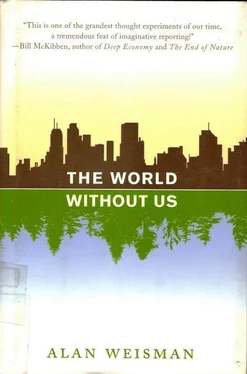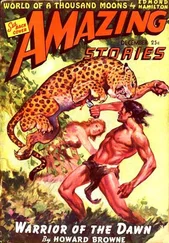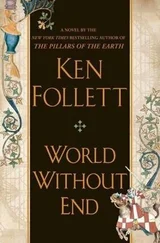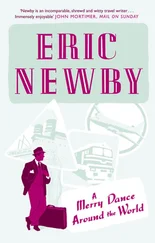Camels eat grass; grass needs water. So did their masters’ crops, whose bounty begat a population boom of humans. More humans needed more herds, pasture, fields, and more water—all at just the wrong time. No one could have known that the rains had shifted. So people and their flocks ranged farther and grazed harder, assuming that the weather would return to what it had been, and that everything would grow back the way it was.
It didn’t. The more they consumed, the less moisture transpired skyward and the less it rained. The result was the hot Sahara we see today. Only it used to be smaller: Over this past century, the numbers of Africa’s humans and their animals have been rising, and now temperatures are, too. This leaves the precarious sub-Saharan tier of Sahel countries at the brink of sliding into the sand.
Farther south, equatorial Africans have herded animals for several thousand years and hunted them even longer, yet between wildlife and humans there was actually mutual benefit: As pastoralists such as Kenya’s Maasai shepherded cattle among pastures and water holes, their spears ready to discourage lions, wildebeest tagged along to take advantage of the predator protection. They, in turn, were followed by their zebra companions. The nomads economized by eating meat sparingly, learning to live on their flocks’ milk and blood, which they drew by carefully tapping and staunching their cattle’s jugular veins. Only when drought reduced fodder for their herds did they fall back on hunting, or trade with bushmen tribes that still lived off game.
This balance among humans, flora, and fauna first began to shift when humans became prey themselves—or rather, commodities. Like our kin the chimpanzees, we’d always murdered one another over territory and mates. But with the rise of slavery, we were reduced to something new: an export crop.
The mark that slavery left on Africa can be seen today in southeastern Kenya, in brushy country known as Tsavo, an eerie landscape of lava-flows, flat-topped tortilis acacias, myrrh, and baobab trees. Because Tsavo’s tsetse flies discouraged cattle herding, it remained a hunting ground for Waata bushmen. Their game included elephant, giraffe, cape buffalo, assorted gazelles, klipspringer, and another striped antelope: the kudu, its horns corkscrewing for an amazing six feet.
The destination for black slaves in East Africa was not America, but Arabia. Until the mid-19th century, Mombasa, on Kenya’s coast, was the shipping port for human flesh, the end of a long line for Arab slavers who captured their merchandise at gunpoint in central African villages. Caravans of slaves marched barefoot down from the Rift, herded by armed captors mounted on donkeys. As they descended into Tsavo, the heat rose and tsetse flies swarmed. Slavers, shooters, and whichever prisoners had survived the journey made for a fig-shaded oasis, Mzima Springs. Its artesian pools, filled with terrapins and hippopotamuses, were refreshed daily by 50 million gallons of water upwelling from porous volcanic hills 30 miles away. For days slave caravans paused here, paying Waata bow-hunters to replenish their stores. The slave route was also the ivory route, and every elephant encountered was harvested. As demand for ivory grew, its price outstripped that of slaves, who became chiefly valued as ivory porters.
Near Mzima Springs, the water outcropped again, forming the Tsavo River, which eventually led to the sea. With shady groves of fever trees and palms, this route was irresistible, but the price was often malaria. Jackals and hyenas followed the caravans, and Tsavo’s lions developed reputations as maneaters by dining on dying slaves left behind.
Until the late 19th century, when the British ended slavery, thousands of elephants and humans perished along the ivory-slave route between the central plains and Mombasa’s auction block. As the slave trail closed, construction commenced on a railroad between Mombasa and Lake Victoria, a source of the Nile, critical to British colonial control. Tsavo’s hungry lions gained international fame for devouring railway workers, sometimes leaping aboard trains to corner them. Their appetites became the stuff of legend and movies, which usually failed to mention that their hunger owed to a scarcity of other game, slaughtered to feed a 1,000-year cavalcade of enslaved human cargo.
After slavery and rail construction, Tsavo was an abandoned, empty country. Without people, its wildlife began creeping back. Briefly, so did armed humans. From 1914 to 1918, Britain and Germany, which had previously agreed to carve up much of Africa between them, were fighting a Great War for reasons that seemed even murkier in Africa than in Europe. A battalion of German colonists from Tanganyika—today, Tanzania—blew up the British Mombasa-Victoria railroad on several occasions. The two sides engaged each other amid palms and fever trees along the Tsavo River, living on bush meat and dying of malaria as much as from bullets, but bullets having the usual disastrous repercussions for wildlife.
Again, Tsavo was emptied. Again, in the absence of humans, it filled with animals. Sandpaper trees laden with yellow saucerberries overgrew the World War I battlefields, hosting families of baboons. In 1948, stating that people had no other use for it, the Crown declared Tsavo, one of human history’s busiest trade routes, a wilderness refuge. Two decades later, its elephant population was 45,000—one of Africa’s biggest. That, however, was not to last.
As the white single-engine Cessna takes off, one of the Earth’s most incongruous sights unfolds beneath its wings. The wide savanna below is Nairobi National Park, where elands, Thomson’s gazelles, cape buffalo, hartebeest, ostriches, white-bellied bustards, giraffes, and lions live jammed against a wall of blocky high-rises. Behind that gray urban facade begins one of the world’s largest, poorest slums. Nairobi is only as old as the railroad that needed a depot between Mombasa and Victoria. One of the youngest cities on Earth, it will likely be among the first to go, because even new construction here quickly begins to crumble.
On its opposite end, Nairobi National Park is unfenced. The Cessna passes its unmarked boundary, crossing into a gray plain dotted with morning-glory trees. Through here, the park’s migrating wildebeest, zebra, and rhinos follow seasonal rains along a corridor lately pinched by maize fields, flower farms, eucalyptus plantations, and sprawling new fenced estates with private wells and conspicuous large houses. Together, these may turn Kenya’s oldest national park into yet another wildlife island. The corridor isn’t protected; with real estate outside of roiling Nairobi becoming increasingly attractive, the best option, in the opinion of the Cessna’s pilot, David Western, is for the government to pay owners to let animals cross their property. He’s helped with negotiations, but he’s not hopeful. Everyone fears elephants squashing their gardens, or worse.
Counting elephants is David Western’s project today—something he has done continually for nearly three decades. Raised in Tanzania, son of a British big-game hunter, as a boy he often hiked alongside his gun-toting father for days without seeing another human. The first animal he shot was his last; the look in the dying warthog’s eyes cooled any further passion to hunt. After an elephant fatally gored his father, his mother took her children to the comparative safety of London. David stayed through university studies in zoology, then returned to Africa.
An hour southeast of Nairobi, Kilimanjaro appears, its shrinking snowcap dripping butterscotch under the rising sun. Just before it, verdant swamps burst from a brown alkaline basin, fed by springs from the volcano’s rainy slopes. This is Amboseli, one of Africa’s smallest, richest parks, an obligatory pilgrimage for tourists hoping to photograph elephants silhouetted against Kilimanjaro. That used to be a dry-season event, when wildlife would pack into Amboseli’s marshland oasis to survive on cattails and sedges. Now they’re always here. “Elephants aren’t supposed to be sedentary,” Western mutters as he passes over dozens of females and calves wading not far from a pod of mucking hippos.
Читать дальше











